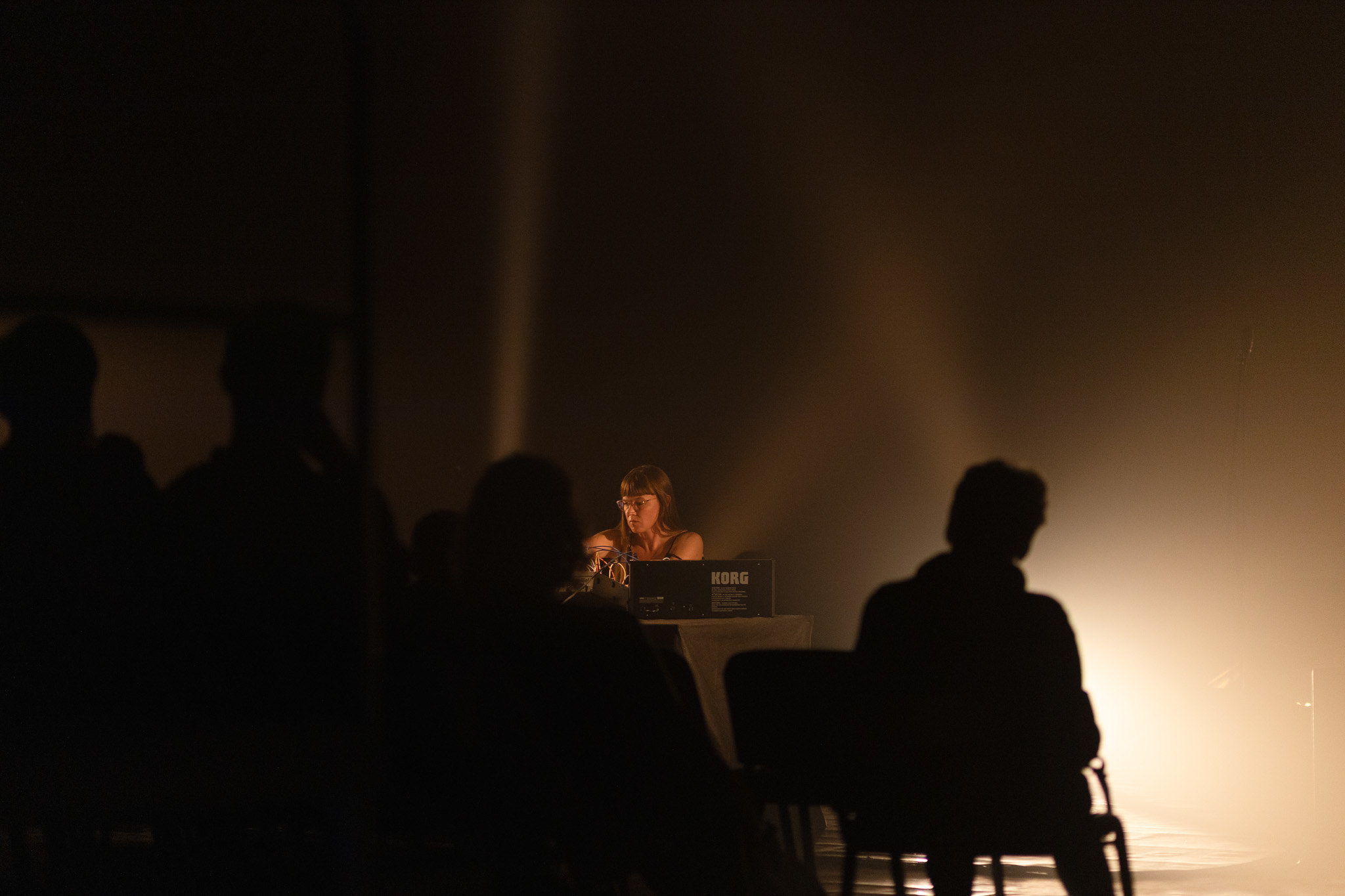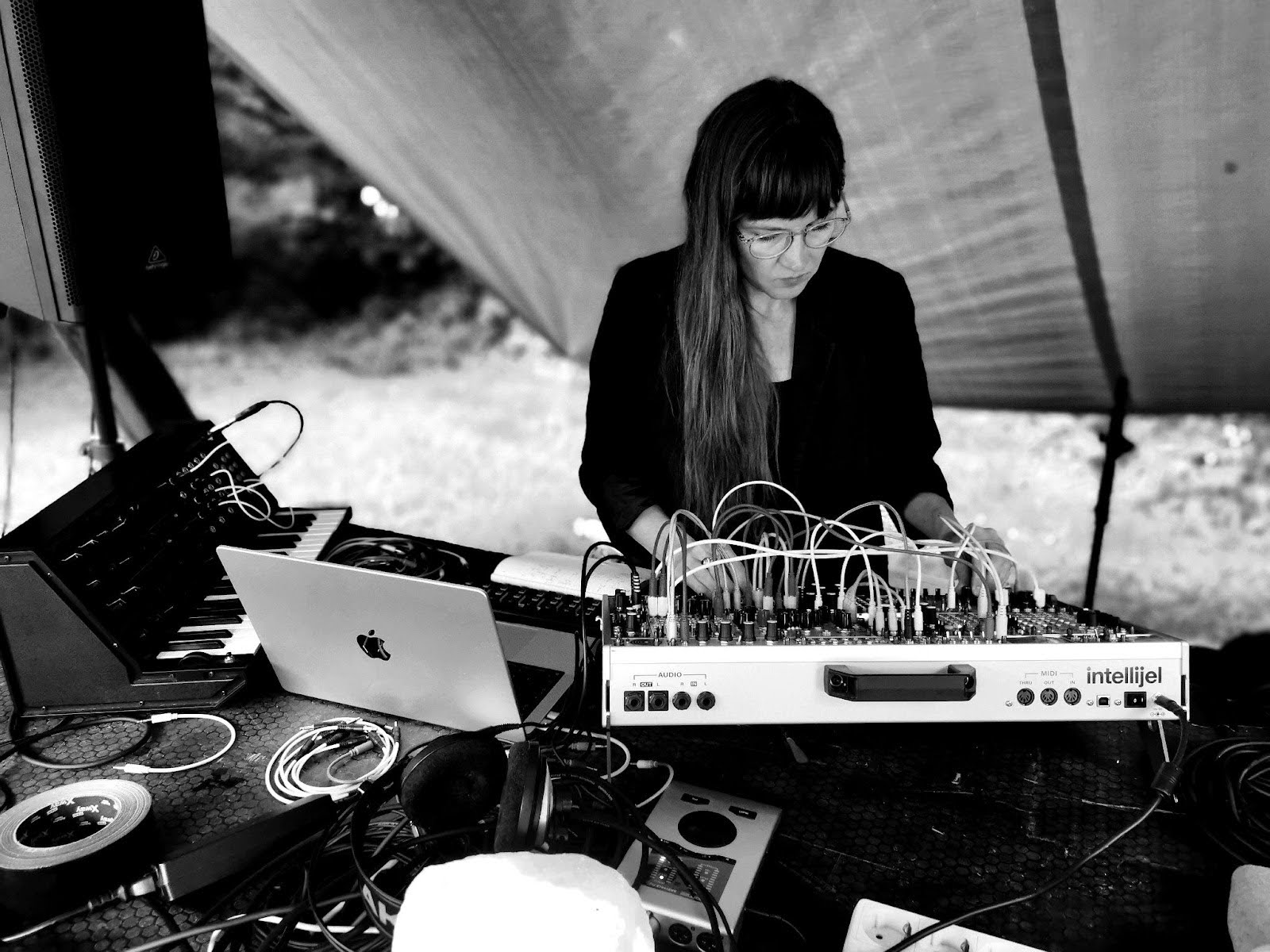
Photo by: Emese Sándor
After a two-month residency at A4 as a part of the Visegrad Art Residency Program, Hungarian sound artist Orsolya Kaincz showcased her piece on the 23rd of September. Known for her innovative approach to electroacoustic experimentation, her residency work touched upon criticisms of capitalism and technological determinism. In this interview, she reflects on her residency, her creative process and journey as a self-taught musician, and how she connects philosophical ideas with sound.
Anete Bužoka (AB): You have been involved in the world of sound and organizing contemporary music events for over a decade – could you introduce yourself to our audience and share how you first became interested in music and sound experimentation?
Orsolya Kaincz (OK): I’m an improviser and sound artist mainly working with electronics. Music has always been at the core of my life in various ways. I always saw it as a shell in which my thoughts could fully melt away.
The fact that I began actively pursuing music is primarily linked to two musician-artist-theorists, whose collaboration brought a paradigm shift in both my musical journey and my thinking.
The first was Zsolt Sőrés who introduced me to the liberating nature of improvisation and opened the door for me to explore works with open structures and alternative notation (e.g., Ernő Király). This process, along with improvisation, reached a more abstract, even conceptual level during my collaboration with composer Nikolaus Gerszewski. He guided me through the depths of music theory through the understanding and performance of works by various contemporary composers, such as Cornelius Cardew, Christian Wolff, Peter Ablinger, and Phill Niblock among others. We also had the opportunity to personally work with several composers, which was an exceptional experience. I believe a third phase is currently beginning, first inspired by my participation in the Listening Academy, organized by Brandon LaBelle about a year ago. His writings and lectures have been highly motivating for me. Around this time, I began to merge my interests in critical theory and sound, a direction that is now taking shape through my research in the Human Ecology program at the University of Pécs.
AB: As a self-taught musician, how did you develop your skills in a field like electroacoustic music?
OK: I originally graduated as an economist, where I was practically taught neoliberal propaganda, so it’s no surprise I have radically moved away from it.
Fortunately there are many informal ways to educate yourself. I have attended workshops, taken private lessons, and even visited some classes at the academy. I have also learned a great deal from fellow musicians and through experimentation. However, for me, the most important aspect is the approach, which I primarily develop by performing contemporary pieces, working with composers, and through extensive listening.
“Residencies are an exceptional opportunity to experiment and work on new concepts. Doing all of this in a completely new environment is very inspiring.”
AB: Let’s talk more about your recent residency here at A4 – could you share some insights from the residency and the creation process of the composition you will be presenting?
OK: Residencies are an exceptional opportunity to experiment and work on new concepts. Doing all of this in a completely new environment is very inspiring. I spent a lot of time at the SNG, especially in its library, studying the graphic scores of Milan Adamčiak and working in this wonderful building. It was motivating to explore, among others, the community activities of Nova Cvernovka and LOM space, as well as the work of the Julius Kollar Society.
While it was inspiring to experience Bratislava, it was also overwhelming and unsettling, as the political climate and the unfolding culture war are unfortunately all too familiar to us in Hungary. At the same time, it was encouraging and hopeful to see people coming together to stand up for their values—and, most importantly, their persistence in doing so. In a situation like this, combined with the ecological crisis, these issues, of course, pervade my thoughts and shape my work, as I see everything through this lens.

Photo by: Eduarda Palmeira
AB: Your pieces often explore strong philosophical narratives, including this residency piece, which touches on a critique of capitalism and technological determinism – how do you approach the process of incorporating these ideas into your compositions? And how do you think sound can serve as a medium for exploring complex ideas?
OK: A piece always ends up being about listening to itself. My goal is to create a contemplative space for the audience, where listening is at the center. Sounds, for me, are like objects of meditation. My underlying inspirations, and narrative, of course, determine the structure and choice of materials, but these thoughts ultimately dissolve into abstraction. What each person discovers in this space is, in part, their work. I am also curious to see what the audience decodes and what thoughts and feelings emerge for them.
“Try to be silent and just listen to the sounds around you. Ask yourself what lies behind the sounding phenomena, both physically and culturally. Consider how these sounds affect you and what kind of atmosphere they create.”
AB: When working on a new project, how do you start? Do you follow a specific process or let the process be more organic as you experiment with different elements?
OK: I’m constantly experimenting. I’m very analytical, and I spend a lot of time on each concept, which is deeply influenced by what I am focused on. I read a lot, listen to music, and experiment with new methods and technologies. It’s like gathering a ton of material, but at the end of the process, you strip away all the frills. At this point, the musical material has a self-evolving process, and improvisation always plays a significant role.
AB: Throughout your career, you have collaborated with many different artists. What do you find most rewarding about working with other artists, and musicians, and how does working with others influence your creative process?
OK: As inspiring as it is, it can also be challenging. A lot depends on the environment and how much time we can dedicate to understanding each other’s perspectives, thinking, and experimenting together. It is increasingly difficult to find the time and space to do this, but it is the only way that makes sense. For example, the formation of the band Kamon Kardamom happened during an impulsive three-day drive from Budapest to Pécs taking a zigzag route. Times like these are very important, and beautiful, and help us to get in tune with one another. Either way, there is always so much to learn from these situations, not least for about yourself.

Photo by: Laszlo Juhász
AB: How can listeners cultivate a more mindful approach to listening and sound in their everyday lives?
OK: Try to be silent and just listen to the sounds around you. Ask yourself what lies behind the sounding phenomena, both physically and culturally. Consider how these sounds affect you and what kind of atmosphere they create. This is going to sound like some mindfulness coach, but try not to take it that way. There are crazy differences in the soundscapes that surround people: some work and live in unbearable noise all day long, while others can immerse themselves in silence within soundproofed spaces, even in a vibrant city. Not to mention the ecological impact of our soundscapes, from the forests to the depths of the sea. Unfortunately, consciously shaping our acoustic environments and valuing silence over the constant—often merely consumption-stimulating—noise is not on the agenda.
AB: What inspires you in your day-to-day life? Also beyond sound and music.
OK: The absence of sound. I have an essential need for silence. When I am surrounded by silence or only natural sounds, it really refreshes me both mentally and physically. Besides, reading and architecture. A good book in a designed space. This is the best.
If I may recommend works by Hungarian writers, I am currently reading Péter Nádas’s A Book of Memories, and G. M. Tamás’s writings are always within arm’s reach. These are available in English translation, and I wholeheartedly recommend them.
More info
Find out more about Orsolya’s work on her webpage.
We are currently having an open call for V4 artists for 2025. The deadline is 9 October to send your proposal to A4.